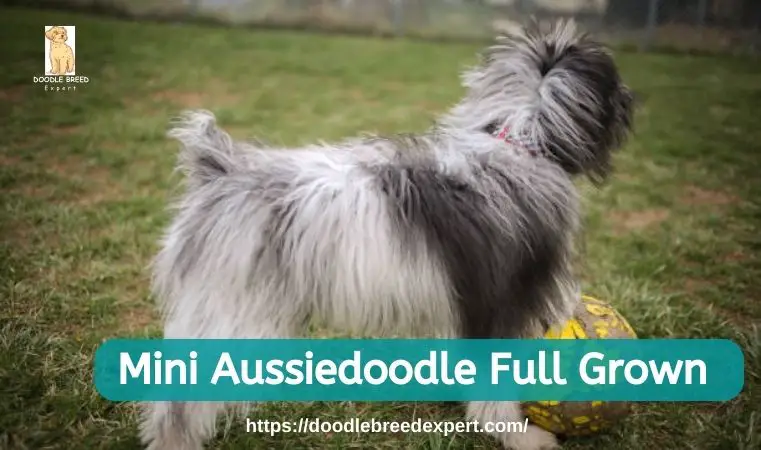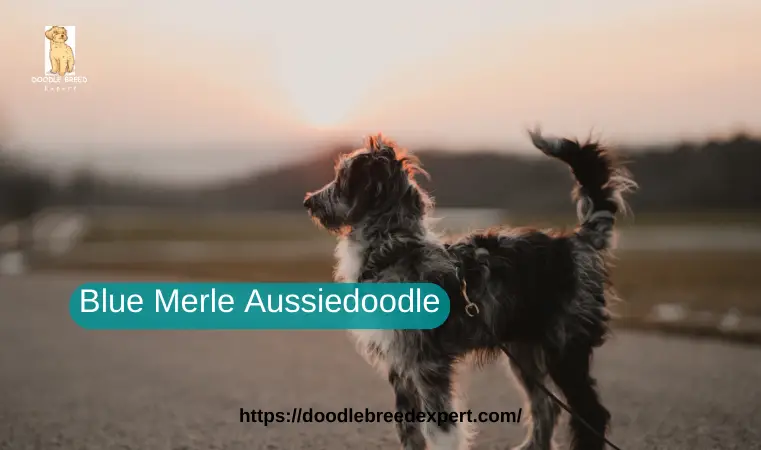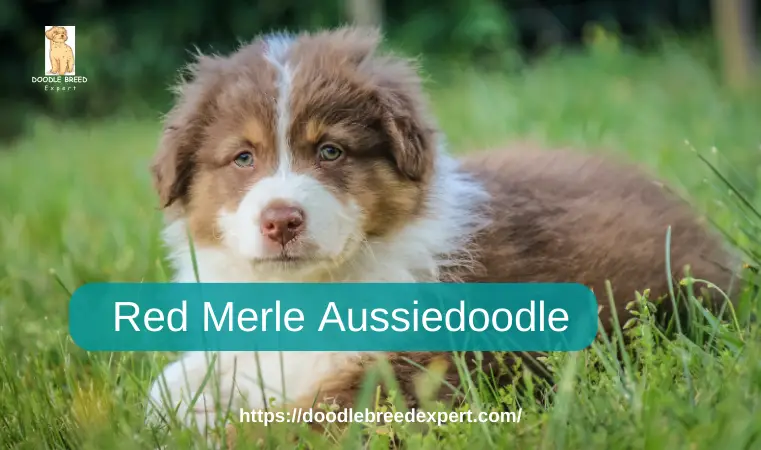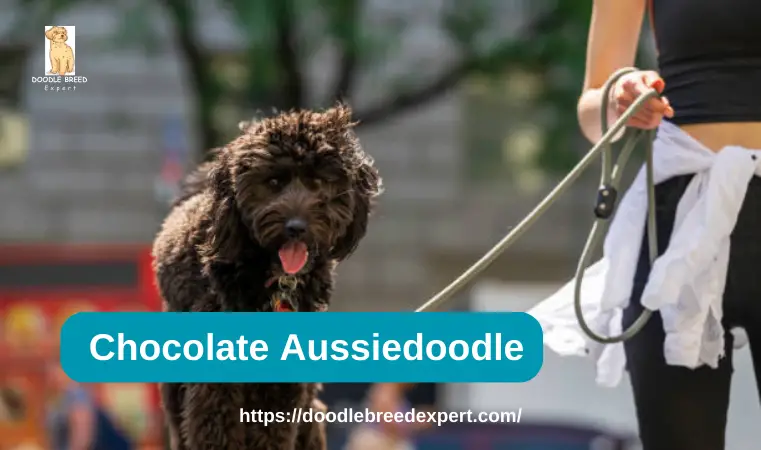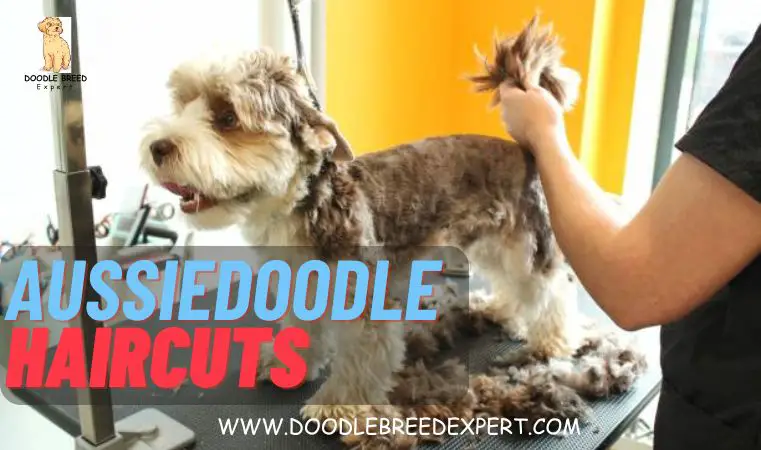The average grown size of an adult and mini Aussiedoodle creates interest and hopeful deliberation for a dog owner. Representing at least one of the results of the most popular breeds, the Australian Shepherd and Poodle, the dogs represent a combination of intelligent, elegant, and cute two breeds that have become increasingly popular among all pets.
Pet parents are constantly wondering to what extent the living space might influence growth and whether it suits them as a lifestyle. When such lovable buddies stop growing, it is a question many of us desire answers to. If you are considering getting a miniature Aussiedoodle or already have one, know how big this breed will get. This introduction seeks to clear the air by touching on some of the questions people have regarding the size that such canine friends grow to be.
The Mini Aussiedoodle Full Grown
One enchanting detail about the Aussiedoodle is their size when they grow up since it has much to do with genetics. Because Purebred Poodles have 78 chromosomes and Purebred Australian Shepherds also have 78, with half the number of each sex from both parents, it plays a significant role in determining what height a canine’s final stature will be. The possible variation is vast because all canines inherit their coding in pairs, but the other factors affecting size include nutrition and health history.
It is even more complex. In designer dog breeds such as the Aussiedoodle, this unpredictability is the most appealing attribute of the breed. No two individuals from the same litter are alike, and each puppy produced by every couplet exhibits a mosaic of features of one or both parents. When the traits of Australian Shepherds and Poodles are mixed, the result is a dog that is somewhat of a hybrid between the two dogs with some intelligence, disposition, and a strong desire to please.
Most significantly important is the fact that the choice of Poodle size for breeding – Standard, Miniature, or Toy – will most certainly influence the future size range of the Aussiedoodle. These factors combine for a pleasing variety of sizes, ensuring each mini Aussiedoodle full grown is a unique and delightful companion reflecting the best qualities of its distinguished lineage.
The Australian Sheperd Influence
The Australian Shepherd, shaped for traits of sheep herding in the United States in the early 1900s, exhibited standout qualities that caused it. Only officially recognized by the American Kennel Club in 1992, these sturdy, sharp, and physically active dogs all make an impact. With skills in flyball and Frisbee trials, they are keen to exercise buddies and do obedience and agility trials.
Having this solid herding instinct, the breed is often observed herding sheep but has also been known to herd babies and ducks. The breed standard specifies a height of between 18 and 23 inches and a weight ranging from between 25 and 70 pounds, with the males generally proportionately more significant than the females.
Their double, medium-length coat is colored in red, black, or blue with striking merle patterns. A rare genetic variation by which the phenotype obtains a mottled or speckled effect, a merle coat occurs as an outcome of a random scattering of a lighter regularity or darkness disposed over a solid color. Sometimes known as a harlequin pattern, this stunning coat pattern can be passed down to Aussiedoodle offspring, resulting in beautiful dogs in all three size categories.
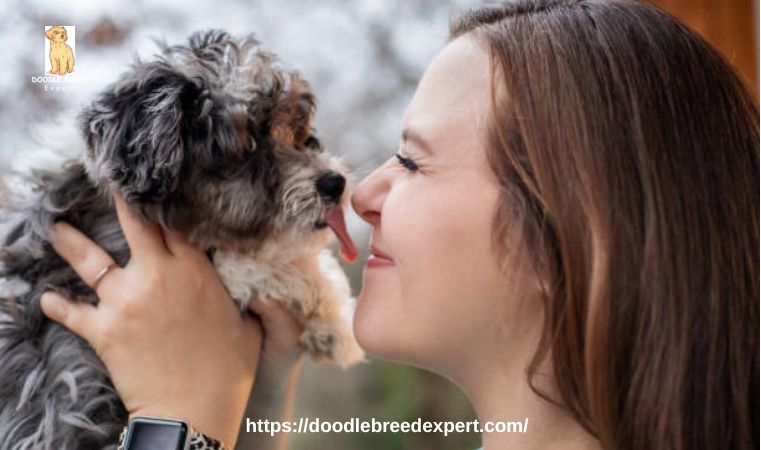
The Poodle Influence
Poodles were originally hunting dogs from France and Germany, boasting many centuries of history. It used to be trained for retrieving waterfowl, having unique fur with intricate styling that helped insulate them against freezing watering. Eventually, the intelligence and trainability of the Poodle led to breeding that produced three distinct size ranges: Standard, Miniature, and Toy.
The largest is the Standard Poodle, growing up to 18 and 24 inches tall and weighing between 44 and 71 pounds. The smallest is the toy poodle, which weighs only 17 pounds and is 9.4 and 11 inches high.
Poodles are famous for their hypoallergenic nature due to the long, tight-curled hair that traps the shed dander against the miss of the undercoat. The breed shows a spectrum of solid colors, including white to gray, tan, brown, black, apricot, and silver, while multicolored individuals do not conform to confirmation standards. This unique curly coat, designed for a low-shed and hypoallergenic effect on dander, influenced, in turn, the hybridistic development of Aussiedoodles and other Doodle crosses.
The Standard Aussiedoodle
Incorporation of the influence of Standard Poodle into breeding protocol yielded the most significant Aussiedoodle variant. Standard Aussiedoodles have a size that ranges from 45 to 70 pounds, whereas their stature is between 19 to 24 inches. It is good to note that bigger sizes, such as that of Standard Aussiedoodles, take a much slower time to mature. While they might appear fully grown by ten months, their development continues for nearly two years, particularly in bone structure.
Aussiedoodles of large sizes must be cared for with a bit of thought. Proper health maintenance can be done only if adequate training is available because of their size. Space should be significant in the sense of having a big yard or enough off-leash means of exercise available. Sparing time to instill basic dog manners cannot be overemphasized since handling a 70-pound dog without proper training will not make life easier. Commitment towards the welfare of these larger breeds entails involvement in their physical and behavioral development but is focused on unique considerations involving their size.
The Miniature Aussiedoodle
The Mini Aussiedoodle fits the description here because, standing a mere 12 to 19 inches from the shoulder, it will weigh between 15 and 35 or 40 pounds. These guys tend to grow faster and are typically mature by about 13 months. The giant breeds have a shorter lifespan where the development process is faster than in a smaller-sized breed with a longer lifespan.
Some families may prefer a Mini Aussiedoodle Full Grown. Their size allows them to fit well in most households, great activity as the other bigger breeds yet not requiring as much space. They are less likely to inadvertently knock you over during play since they are smaller and have more minor dietary requirements than larger Aussies.
The Toy Aussiedoodles
The slightly larger Toy Aussiedoodle, standing at 10 to 12 inches, weighs around 6 to 15 pounds. They typically reach maturity during adulthood before their first birthdays.
Despite their small size compared to larger breeds, toy-sized dogs require the same amount of exercise and training. It’s crucial to be mindful of their size to avoid accidentally stepping on them, but they shouldn’t be treated as fragile or overly delicate. Toy Aussiedoodles can thrive in a modest apartment setting with proper attention and playtime.
Small-sized dogs like Toy Aussiedoodle work just perfectly in the lives of senior citizens. With a height that is not much greater than an average man’s knee, the dog has enough energy to keep those seniors on their toes and, quite literally, give them a run for their money.
When Does An Aussiedoodle Stop Growing?
In light of this, with the maximum size of an Aussiedoodle factored in and the elements that affect this size factored in, having acquired a fully developed breed then narrows down to how long this particular canine breed becomes fully developed.
Without a doubt, Australian shepherds stop developing at around 16 months. Poodles realize this around the same age. Similarly, standard Aussiedoodles take sixteen months to attain their full size. The Toy and Mini Aussiedoodle Full Grown variations shall reach maturity approximately one to two years earlier.
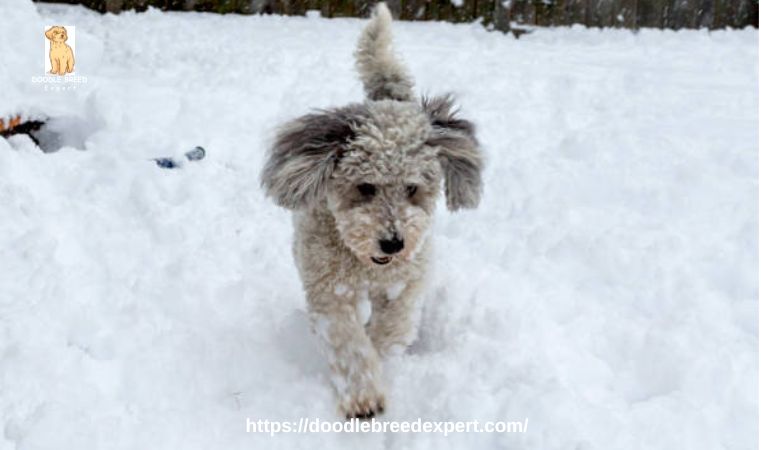
History of Mini Aussiedoodle Full Grown
This breed has been carefully bred by crossing a purebred Miniature Poodle with a purebred Australian Shepherd. The ultimate target was to combine the hypoallergenic coat qualities and refined temperament of poodles with the hardy nature, vibrant personality, superior intelligence, and mastery of mini Australian shepherds. As the Mini Aussiedoodle gained attention, more so that it had already become a fad in Hollywood, breeders continued to develop the breed, mostly with variations in size and generations.
Currently, the three generations of Mini Aussiedoodles are most preferred: F1, F1b, and F2. These generational differences further define the breeding lineage and the characteristics that go with individual dogs within the breed of a Mini Aussiedoodle. This hybrid’s ongoing development and popularity showcase the continuous evolution of designer breeds in response to specific traits and preferences desired by dog enthusiasts.
F1 Mini Aussiedoodles
F1 Mini Aussiedoodles are first-generation hybrids or miniature poodles bred to mini Australian shepherds. They inherit characteristics from both of their parent breeds as they are a mix of appearances and personality traits, making them different than the usual hybrid miniature breed mixes. What gives outstanding traits to F1 Mini Aussiedoodles is the combination of qualities in the two parental breeds of Poodles and Mini Australian Shepherds.
General health status emitted as an effect of hosting F1 hybrids on the other principal benefit. This has been mainly attributed to the initial crossbreeding, which introduces vitality gained through genetic diversity. Their infusion of genetic diversity in F1 Mini Aussiedoodles benefits these dogs by giving them a wider spectrum of genes than the parent breeds; thus understandably preparing them to avoid the risk of inheriting many health issues they could be subjected to. F1b Mini Aussiedoodles.
F1b Mini Aussiedoodles
The F1b Mini Aussiedoodles are bred from the cross between a Mini Poodle and an F1 backcross, and this parent is mostly called second-generation hybrids. These dogs have to have the characteristics of hypoallergenic quality and coat of the Poodle that will also make them suitable for people with allergies. Additionally, F1b Mini Aussiedoodles tend to be more compact than their F1 counterparts.
On the other hand, F2 Mini Aussiedoodles breed between two Mini Aussiedoodles, so they are considered third-generation crossbreeds. Breeding such puppies is with specific physical and personality qualities in mind such that the qualities are supposed to be refined and magnified over the qualities seen in the earlier generations.
Variations within the breed must be noted to introduce size differences. There is a standard Mini Aussiedoodle but also Toy, Teacup, and Micro Mini-size variants. These can or cannot be as popular, keeping in line with the adage that different strokes suit different folks.
It is worth mentioning that there are more significant variations of doodle breeds known as Standard Aussiedoodles. These designer dogs are bred from a standard Poodle and an Australian Shepherd, thus creating larger pups for those wanting more substantial companions.
While the exact historical context of the doodle breeds is a little hazy, examining the characteristics and traits of the parent breeds, especially the Mini Australian Shepherd and the Mini Poodle, can provide clues on how these hybrid dogs were developed.
The Miniature Australian Shepherds
The Miniature Australian Shepherd was developed in the United States in 1960 by selectively breeding the most miniature puppies available. The purpose of this selective breeding was to bring forth a smaller version of an Australian Shepherd yet be able to possess all the great traits intact in an Australian shepherd. The resultant Miniature Australian Shepherds have proved to be versatile and capable dogs excelling in diligent herding, agility sports performance, therapy dogs, and a loving, caring companion. This breed quickly gained popularity in the United States and throughout Europe.
Poodles have a long history of earning fame and are popular worldwide for their elegance and agility. The fact that Poodles were initially the companions of royalty, nobles, and members of the higher class has earned them respect. A poodle is known as a “Dog with a royal attitude.”
Apart from being pets, Poodles earned fame as show dogs that accompanied their various coat fashions and ever did tricks on traveling circuses. Poodles have become well-loved playmates and athletes with much following among pet owners. They rank among the world’s most popular dog breeds and are established as the second most intelligent dog breed globally. Mini Poodles, for that matter, are very much preferred when pet-keeping in United States apartments.
Appearance of Mini Aussiedoodle Full Grown
The Mini Aussiedoodles are simply a crossbreeding between the Miniature Poodle and the Miniature Australian Shepherd. The Mini Australian Shepherds, on the other hand, also have miniature statures yet are robust with distinguished coat patterns. They are small-sized, hypoallergenic, deficient shedding dogs that make them convenient in households where owners either have allergy tendencies or are super sensitive to dog fur and dander.
The pups, having received only the positive traits from both parents, Mini Aussiedoodles are dogs with an overall look that is quite graceful due to their strong and current build. The long, wiry coat of the dog will be feathered in the thorax, ears, tail, and even on the legs, while the texture can be curly, straight, or wavy.
The eyes of Mini Aussiedoodle Full Grown are often hazel, blue, black, or brown. They tend to have average muzzle lengths, and their ears are triangular. Mini Aussiedoodle Full Grown can best be described as small to medium-sized, depending on the proportion of inheritance from both parents. When fully grown, these dogs typically stand between 12 to 18 inches tall and weigh 15 to 35 pounds. When fully grown, these dogs usually stand between 12 to 18 inches tall and weigh 15 to 35 pounds.
Mini Aussiedoodle Full Grown Temperament
Miniature Aussiedoodles have outstanding qualities that enable families and individuals to own them. They are docile and friendly, allowing them to grow and interact well with children and strangers. That said, be cautious of their slight prey drive, meaning they will require leash walks to limit their enthusiasm around small dogs.
Energetic dogs like them will always be finding fun things to do. Some games are chasing, fetching, walking beside a long lead, and running and hiking around the block. This makes them more compatible with children with exuberance for activity and playful moments. Despite their love for the outdoors, Mini Aussiedoodles are fond of time spent indoors with family or separately on the couch curled up.
With an adorable appearance, a gentle temperament, and good behavior, Mini Aussiedoodles appeal to many dog owners. They possess attributes of being quiet and not too much of a heavy barker, thus making them very good apartment dwellers.
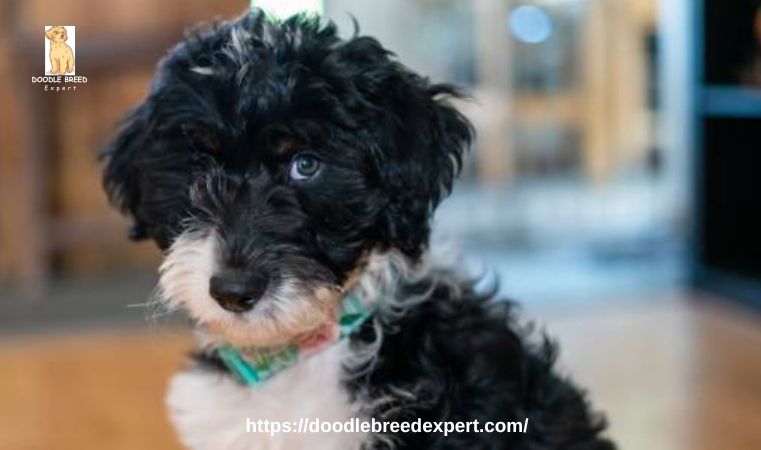
Care of Mini Aussiedoodle Full Grown
Mini Aussiedoodle Grooming
Mini Aussiedoodles need grooming just like any other average dog. Essential grooming should be done at least twice a week, including combing, brushing, occasionally bathing, trimming ear hair, clipping nails, and cleaning their teeth. The dogs are generally short in height, unlike most other dog breeds. Brush weekly to keep his coat shiny, avoid tangles, and bathe monthly for two months. Weekly tooth brushing and routine ear cleaning with a damp cloth will not become an issue. Trim their nails every two months or as needed for optimal care.
Mini Aussiedoodle Exercise Needs
Though small and excellent in size, Mini Aussiedoodles have great energy to waste. These dogs love the outdoors, like dog sports, activities, hikes, etc. Some usually live active lives; therefore, regularly exercising is necessary. An ideal Mini Aussiedoodles exercise routine includes a morning walk, an evening walk, plenty of indoor games, and active play. Including jogs, runs, or occasionally planning a dog park visit are other ways to keep your dog happy and perfectly healthy.
Mini Aussiedoodle Health
The highest attainable health characterizes Miniature Australian Doodles. Bred as the result of a crossbreeding between purebreds, Mini Aussiedoodles take on a vast gene pool that gives some resistance to the high risk of specific ailments in the breed from whence they come. More likely, their lineage may have something to do with the possible appearance of health issues such as cataracts, hip dysplasia, retinal atrophy, and skin irritations. Mini Aussiedoodle Life Span On average, the Mini Aussiedoodle Full Grown lives between twelve and fifteen years.
Mini Aussiedoodle Lifespan
While the norm expectancy lies between 14 and 15 years, cases of dogs reaching beyond 16 years have been reported. Feed your tiny four-legged friend with high-quality dog food, make regular trips to your veterinary specialist, and enjoy a long, happy life together.
Mini Aussiedoodle Training
Mini Aussiedoodles are high on intelligence and a strong will to please, which is the inheritance from their parent dogs. These enthusiastic about absolutely new challenges and take great interest in these. They are fast learners and have nothing much to love besides learning tricks and some basic commands. On the contrary, these constantly seek a reason to impress the owners.
Some enjoyable diversions and fun games will be needed when the time comes to train these intelligent, active puppies. They are usually sensitive and poor at taking yelling or punishment, so avoid harsh treatment that could turn them timid or hostile. Instead, they use their favorite dog toys, positive reinforcement, and tasty treats as rewards.
Miniature Aussiedoodle puppies love socialization. Naturally, they love humans, other dogs, and pets. However, continuous socialization is highly recommended. Creating a safe, distraction-free environment and gradually introducing your puppy to friends or family members is the best approach to puppy socialization.
Conclusion: Mini Aussiedoodle Full Grown
Aussiedoodles have grown in popularity, and it is no wonder they have all the best features of a Poodle and an Australian Shepherd. It has a nice feature following its willing-to-please characteristic and is also intelligent and friendly.
Coming in three available sizes to accommodate different lifestyles, Aussiedoodles are trainable to perform several purposes. The herding instinct is something they inherited from Australians and can be conducted into one’s daily enjoyment. Still, high energy may require significant amounts of daily exercise to keep them from getting bored with life, thus the importance of forming interesting and active entertainment for them to let out some of that pent-up energy.
Aussiedoodles can live from ten to fourteen years with proper care. Suppose the dog is offered an opportunity for a healthy beginning in early training. In that case, it will not only lead to its having the best dog experience but guarantee that undesirable behaviors do not become established habits.
Although hybrids often exhibit better health than purebreds in their majority, both Australian Shepherds and Poodles are victims of genetic weaknesses. A good relationship with a veterinarian is the key to your dog’s best health during their entire life. Like human systems, dogs also need three constituents – a sound diet, exercise, and prophylactic care.
Considering available space, time commitment, and a willingness to coexist with these charming canines, adding an Aussiedoodle to your household could be an ideal choice.
References:
- Cosgrove, N. (2023, August 17). Miniature Aussiedoodle: Dog Breed Info, Pictures & Facts. Hepper. https://www.hepper.com/miniature-aussiedoodle/
- Jones, R. (n.d.). Miniature Aussiedoodle. WagWalking. https://wagwalking.com/breed/miniature-aussiedoodle
- Team, F. (2023, September 10). Mini Aussiedoodle: Blend of Australian Shepherd and Poodle! Off Leash Blog. https://blog.tryfi.com/mini-aussiedoodle/
- Clancy, M. (2024, January 5). Aussiedoodle. DogTime. https://dogtime.com/dog-breeds/aussiedoodle
- Kelley, T. L. (2021, May 8). Aussiedoodle. Daily Paws. https://www.dailypaws.com/dogs-puppies/dog-breeds/aussiedoodle
- Miniature Aussiedoodle BreedInfo. (n.d.). https://www.coursehero.com/file/117105405/Miniature-Aussiedoodle-Breed-Infopdf/
